An Island Country of the Mediterranean
We had a miserable stay on Malta. It’s not to say that Malta is a dull island
filled with nasty inhabitants. In fact I
think Malta would be a lot of fun and offer many enriching activities to
visitors under the right circumstances. The
circumstances we visited the island under, between overcast weather, the day of the week (a Sunday when much is
closed), and being sold a tour that wasted most of our time, Malta marked a
down point on our tour of the Mediterranean.
 |
| The new cities of Malta look typical of the Mediterranean. |
Malta for those who have never heard of it, is a small
island nation about sixty miles south of Sicily. Malta like so many islands of the
Mediterranean was inhabited and thus influenced by other countries, most
recently (until 1964) by the United Kingdom.
The result is an island that has retained its own history and culture,
such as the Maltese language, while attaining attributes of other cultures,
such as the second official language of English and food that is eerily similar
to Italy.
 |
| Glass blowing on the island of Malta; larger pieces seemed to be more popular here than in Venice. |
Our cruise ship was to dock in Malta adjacent to the city of
Valletta for a substantial amount of time, from ten in the morning until
nine-thirty at night. With so much time
in port, I thought we could be flexible with our time to see as many sites as
possible and still make it back to the ship with plenty of time before setting
sail.
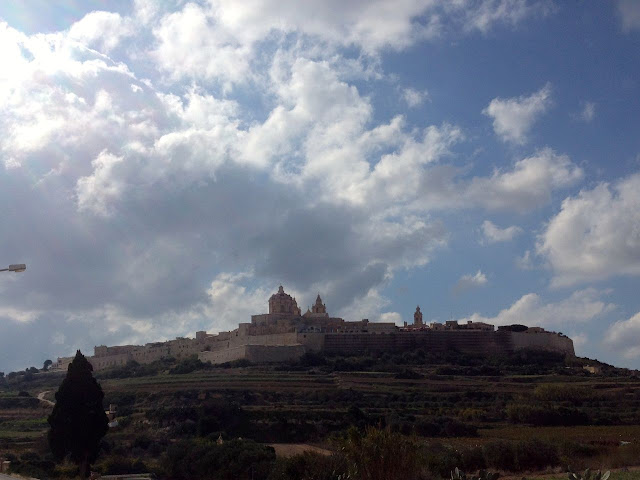 |
| Mdina, the ancient silent city, is in a defensive position on the highest point in the center of the island. Pirates seemed to cause all of Malta's architectural unique characteristics. |
I did do a bit of research up front and downloaded an app to
my phone that supposedly offered walking tours of Cagliari. I turned it on as soon as we got in to
port. To my supreme disappointment, as
useful as the iRhodes app was for Rhodes, the Cagliari app was a complete failure
for Cagliari. Not only did the supposed
routes lack directions, but every time I clicked a link within the app it froze
and told me to turn on my data. Out of
home country data is extremely expensive, and I was not going to run up a
hundred dollar bill on my phone plan to use a little walking tour app. The app also would not need data if it
contained directions as in the iRhodes app.
So with a useless app (which cost double the very useful iRhodes app), I
was open for finding an alternative activity once we left the port.
 |
| The entrance to Mdina, a narrow gate meant to keep out pirates. |
At the port entrance we fond our alternative, a hop on hop
off bus. It cost ten euro, and its two
routes encircled pretty much all of the island.
We were told the buses stopped running at five thirty in the evening,
and as it was only eleven in the morning, we thought we had plenty of time to
complete both routes. After all we have
had such success with using similar bus companies, in Cartagena, Athens, and
Dublin. The bus system seemed easy
enough; jump on a blue bus to go on the blue route and a red bus to go on the
red route.
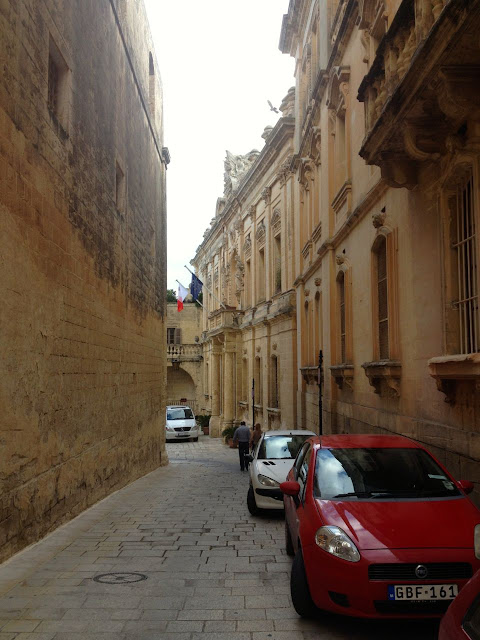 |
| The narrow winding streets of Mdina allowed its inhabitants a chance to hide from pirates. |
We boarded a red bus since it would visit some sites I had
seen on a documentary about Malta, most notably megalithic structures (much
like Stonehenge) dating to the Neolithic and a cave and associated museum where
fossils of ancient animals unique to Malta (including mostly miniaturized
animals found on the African continent, such as pygmy elephants). We plugged in our complimentary head phones
and listened to the supposed audio tour, although it seemed for every twenty
minutes of bus riding we heard only two minutes of audio.
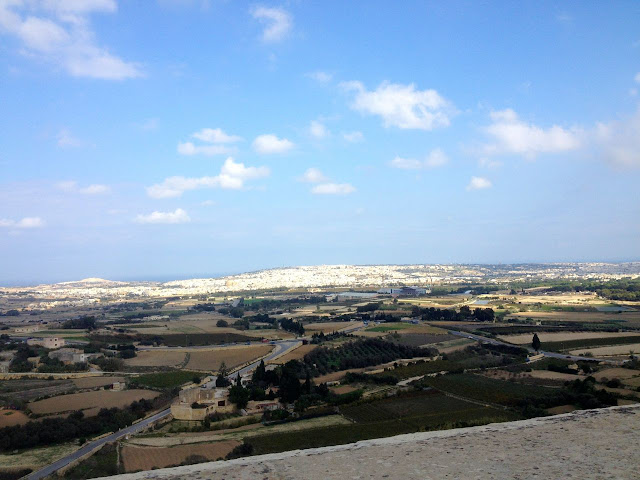 |
| From the heights of Mdina, it's easy to see the ocean. |
It therefore took us about twenty minutes to realize that
though we were on a red bus, we were going along the blue route in the
completely different direction. It was
still early we reasoned, and so we decided to make the best of the situation by
visiting the more famous stops along the blue route, most notably the ancient
capital of Mdina, also known as the silent city.
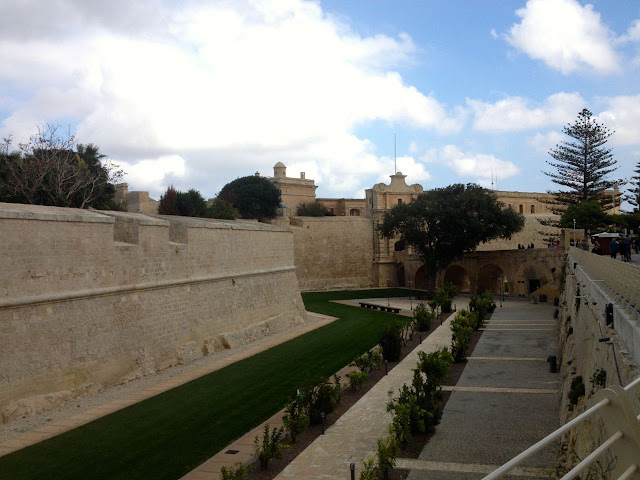 |
| An empty mote surrounds Mdina, more protection from pirates. |
As much as other cultures, Malta has been influenced as much
by piracy. This is no clearer than in
Mdina. Evidence of efforts to thwart
piracy attacks from nearby Africa and Europe is everywhere. The medieval cities all lie miles
inland on high ground, with Mdina perched on the highest point of the
island. Large walls encircle the city
with only a few small gates allowing entry, forcing pirates who have made the
long trek from the sea to bottleneck in on narrow bridges. Once inside the narrow and twisting streets of
the city provide residents a few extra precious moments to hide from the
swashbuckling intruders.
 |
| David waits for the bus in Saint Paul's Bay, a bay where the apostle Paul was shipwrecked on his way to Rome. |
Indeed running and hiding was the main strategy of the
medieval Maltese. Although fortified
towers encircle the island, they were for monitoring purposes only, not
battle. At the sighting of a pirate vessel,
watchmen stationed at a tower would light a fire or fire a cannon that would
inform the nearest watchtowers of the threat.
The watchmen would then mount their trusty steed and high tail it to the
fortified medieval cities of the interior, notifying farmers along the
way.
Aside from the constant threat of pirates medieval Malta was
a miserable place to live. With no lakes
or rivers and an extensive dry season, careful rationing of water was necessary
to the survival of the inhabitants. Much
of the plants adapted to the drier climate, although they don’t keep as well as
other varietals elsewhere in the world. An
entire crop could be lost if harvest was not conducted at breakneck speed. Proprietary Maltese dishes are usually rabbit
based, as rabbit is the largest meat native to the island. While my trip to Malta may have been riddled
with speed bumps, at least I did not visit in the middle ages.
 |
| Cagliari is beautiful at sunset. |
Back to our time in Mdina.
We only spent thirty minutes inside the city of Mdina. It is a relatively small city, with quiet
deserted streets. At its edges, the
ramparts of Mdina offer a view clear to the sea. It was a quaint model of a city, but we were
getting hungry.
 |
| These beautiful gardens are what the Cagliari lift opens up to. Beneath them are the war rooms where visitors can see old weapons and other military paraphernalia. |
We decided to save time we should grab some food to go and
munch on the bus. Three food stands were
situated outside Mdina’s walled, and despite the seeming variety of takeaway
food in their display cases, they all lacked vegetarian options. So we climbed back on board deciding we would
grab a bite back at the cruise terminal when we could finally get on the red
bus.
 |
| Mdina can be seen from Cagliari. Its silhouette is off in the distance to the right. |
I decided to read the timetable and see when that would
be. To my dismay I discovered that it
would not be for another hour and a half, the entire route requiring over two
hours to complete. I also discovered
that the last red bus left the port at three in the afternoon, and returned to
the port at five-thirty. Yes indeed the
buses ran until five-thirty, as we were informed when we bought the
tickets. With the extensive route of the
blue bus, we would not make it back to the port in time to catch the last
bus. Even if we did catch it, we could
not get off at any of the stops we wanted to.
It appeared the rest of the passengers were realizing the same issue as
us. In total we would spend over two
hours bumbling along in an old uncomfortable bus to spend thirty minutes in
Mdina, what a waste. The bus employees
told us we could do both routes, but they lied.
We didn’t have the time, and they were aware of that. With a little talking and a fast transaction they sabotaged our day.
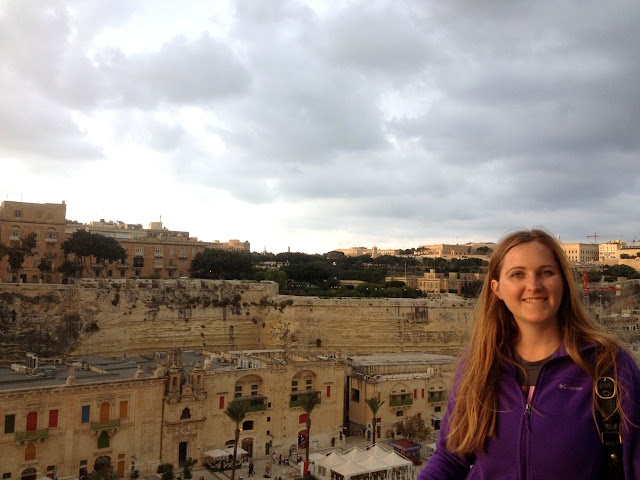 |
| The cruise terminal has a lot of nice restaurants on quaint promenade below the cliffs of Cagliari. |
About an hour into our ride back to port, we entered a
larger city along Saint Paul’s Bay, so called because Saint Paul was
shipwrecked their for months on his way to Rome. His preaching brought Christianity to Malta,
where it is still the main religion. We
did not see a lot to do in that city, but there were a lot of restaurants. Since we were starving and not going to make
it back to the port in time for the other bus, we got off in search of
lunch. The beer was good and the food
rich. I got a pizza and David chicken
wings. The restaurant called them
buffalo wings, but unlike buffalo wings in the US (where they were invented)
these wings were drenched in a sauce primarily composed of tomato paste and
cayenne pepper. It was hot without a lot
of flavor. My pizza was of the Italian
style, that is to say about twelve inches across with not a lot of sauce. The crust was thicker than I had encountered
anywhere in Italy though. The food was
sufficient, but the service slow. We
waited fifteen minutes before we even got a menu, wasting more of our precious
time.
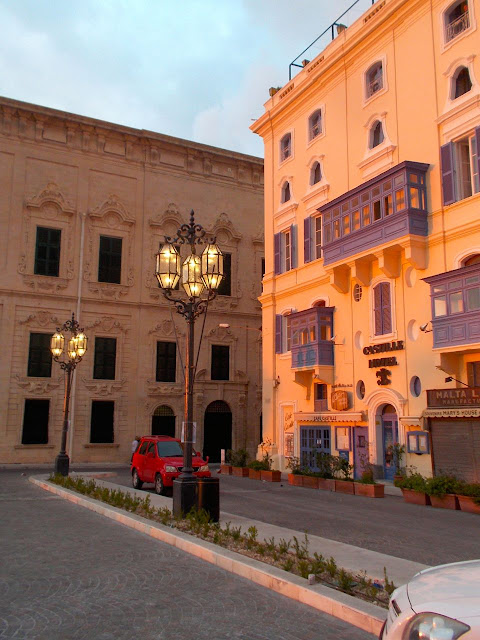 |
| The streets of Cagliari awash in the light of dusk. |
As we ate lunch is started drizzling on and off. This rain pattern would continue through the
evening. Eventually we boarded the bus
back to the ship, where we arrived at about sunset. Having arrived back at the port David and I
decided to try anew. We would put the
buses (which were no longer running) behind us and enjoy our remaining time
exploring Caglirari.
 |
| A street of Cagliari on Sunday night, despite the abundance of people most shops and restaurants were closed. |
Caglirari is set high above the harbor, with stone walls
several stories high setting it apart from the water below. We took a lift (elevator) from the harbor up
to the city at the cost a euro round trip.
The top of the lift opened up into a beautiful garden with magnificent
views and the streets of Cagliari. Walking
around Cagliari was pleasant, especially with the cool night air settling in. Its streets are picturesque and mostly
pedestrianized. Unfortunately, I cannot
tell much more than that. Being a Sunday
evening most every store, restaurant, museum, and bar was closed. I checked out the hours of a few stores and
saw many closed as early as two in the afternoon. It seems to experience Cagliari, its better
to visit on any other day than Sunday.
 |
| Why climb up to Cagliari when for a few dollars we could take an elevator? |
We headed back to the cruise harbor, which was still alive
with life. The cruise terminal is set up
nicely, in the style of many gentrified areas in the US sporting trendy stores
and restaurants. We had a few more
Maltese beers before getting back aboard and saying adieu to the island
country. Malta is not easy to get to for
most Americans, and I probably won’t be back, at least for a long time.
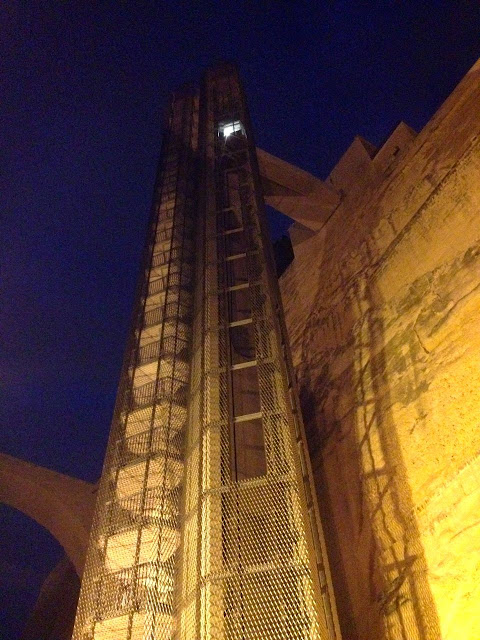 |
| The lift of Cagliari is dramatic against its steep walls. |
It’s a shame; I was really looking forward to visiting Malta. David put it well when he said every port
cannot be a home run. Malta will just
have to be a strike out for now. If I go
back I will be sure to not make the same mistakes.
No comments:
Post a Comment